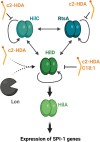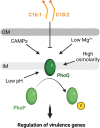Anti-infective activities of long-chain fatty acids against foodborne pathogens
- PMID: 37437907
- PMCID: PMC10368373
- DOI: 10.1093/femsre/fuad037
Anti-infective activities of long-chain fatty acids against foodborne pathogens
Abstract
Free fatty acids (FFAs) have long been acknowledged for their antimicrobial activity. More recently, long-chain FFAs (>12 carbon atoms) are receiving increased attention for their potent antivirulence activity against pathogenic bacteria. In the gastrointestinal tract, foodborne pathogens encounter a variety of long-chain FFAs derived from the diet, metabolic activities of the gut microbiota, or the host. This review highlights the role of long-chain FFAs as signaling molecules acting to inhibit the infectious potential of important foodborne pathogens, including Salmonella and Listeria monocytogenes. Various long-chain FFAs interact with sensory proteins and transcriptional regulators controlling the expression of infection-relevant genes. Consequently, long-chain FFAs may act to disarm bacterial pathogens of their virulence factors. Understanding how foodborne pathogens sense and respond to long-chain FFAs may enable the design of new anti-infective approaches.
Keywords: Listeria monocytogenes; Salmonella; antimicrobial activity; antivirulence activity; foodborne pathogens; long-chain free fatty acids.
© The Author(s) 2023. Published by Oxford University Press on behalf of FEMS.
Conflict of interest statement
The authors declare no conflict of interest.
Figures






Similar articles
-
Free Fatty Acids Interfere with the DNA Binding Activity of the Virulence Regulator PrfA of Listeria monocytogenes.J Bacteriol. 2020 Jul 9;202(15):e00156-20. doi: 10.1128/JB.00156-20. Print 2020 Jul 9. J Bacteriol. 2020. PMID: 32393522 Free PMC article.
-
Long-chain unsaturated free fatty acids reduce the host cell invasion of Listeria monocytogenes outbreak strains.Front Cell Infect Microbiol. 2025 Feb 28;15:1542165. doi: 10.3389/fcimb.2025.1542165. eCollection 2025. Front Cell Infect Microbiol. 2025. PMID: 40093538 Free PMC article.
-
Antimicrobial medium- and long-chain free fatty acids prevent PrfA-dependent activation of virulence genes in Listeria monocytogenes.Res Microbiol. 2017 Jul-Aug;168(6):547-557. doi: 10.1016/j.resmic.2017.03.002. Epub 2017 Mar 23. Res Microbiol. 2017. PMID: 28344104
-
Long Chain Fatty Acids and Virulence Repression in Intestinal Bacterial Pathogens.Front Cell Infect Microbiol. 2022 Jun 17;12:928503. doi: 10.3389/fcimb.2022.928503. eCollection 2022. Front Cell Infect Microbiol. 2022. PMID: 35782143 Free PMC article. Review.
-
Drugs or diet?--Developing novel therapeutic strategies targeting the free fatty acid family of GPCRs.Br J Pharmacol. 2013 Oct;170(4):696-711. doi: 10.1111/bph.12327. Br J Pharmacol. 2013. PMID: 23937426 Free PMC article. Review.
Cited by
-
Albumin orchestrates a natural host defense mechanism against mucormycosis.Res Sq [Preprint]. 2024 Dec 3:rs.3.rs-5441197. doi: 10.21203/rs.3.rs-5441197/v1. Res Sq. 2024. PMID: 39678331 Free PMC article. Preprint.
-
Alpha-linolenic acid-modified liposomes associate with and modulate antibiotic activity against Helicobacter pylori.Microbiology (Reading). 2025 May;171(5):001562. doi: 10.1099/mic.0.001562. Microbiology (Reading). 2025. PMID: 40445841 Free PMC article.
-
A unique combination of natural fatty acids from Hermetia illucens fly larvae fat effectively combats virulence factors and biofilms of MDR hypervirulent mucoviscus Klebsiella pneumoniae strains by increasing Lewis acid-base/van der Waals interactions in bacterial wall membranes.Front Cell Infect Microbiol. 2024 Jul 25;14:1408179. doi: 10.3389/fcimb.2024.1408179. eCollection 2024. Front Cell Infect Microbiol. 2024. PMID: 39119288 Free PMC article.
-
Key enzymes involved in the utilization of fatty acids by Saccharomyces cerevisiae: a review.Front Microbiol. 2024 Jan 11;14:1294182. doi: 10.3389/fmicb.2023.1294182. eCollection 2023. Front Microbiol. 2024. PMID: 38274755 Free PMC article. Review.
-
The apple of discord: can spider cocoons be equipped with antimicrobial factors?-a systematic review.Front Zool. 2025 May 28;22(1):9. doi: 10.1186/s12983-025-00563-5. Front Zool. 2025. PMID: 40437581 Free PMC article. Review.
References
-
- Arslan S, Eyi A, Ozdemir F. Spoilage potentials and antimicrobial resistance of Pseudomonas spp. isolated from cheeses. J Dairy Sci. 2011;94:5851–6. - PubMed
-
- Bader MW, Sanowar S, Daley MEet al. . Recognition of antimicrobial peptides by a bacterial sensor kinase. Cell. 2005;122:461–72. - PubMed
-
- Bajaj V, Hwang C, Lee CA. hilA is a novel ompR/toxR family member that activates the expression of Salmonella Typhimurium invasion genes. Mol Microbiol. 1995;18:715–27. - PubMed

